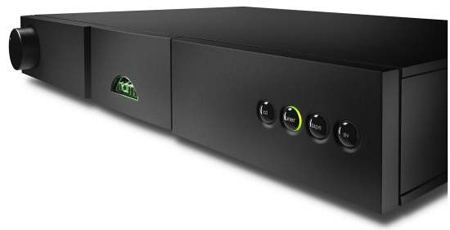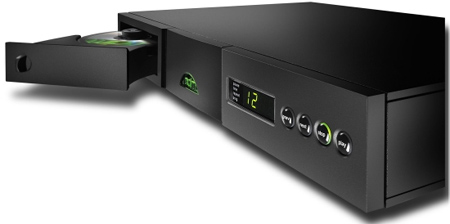You are reading the older HTML site
Positive Feedback ISSUE
18
march/april 2005
naim
Nait 5i integrated and a brief bit on the CD5i CD player
as reviewed by Jim Grudzien

|
JIM GRUDZIEN'S SYSTEM LOUDSPEAKERS ELECTRONICS SOURCE CABLES ACCESSORIES
|
A year or two ago, I was urged by another PFO reviewer to listen to the Naim Nait 5 integrated amplifier, as he suggested that it might be a good match for my Dali Grand loudspeakers and my soft, lush sounding Arcam CD player. Naim has now come out with an upgraded version, the Nait 5i. The new model has a 66 percent increase in power, to 50 watts per channel, and Naim has added RCA inputs in addition to their traditional DIN connectors. The 5i is also less expensive, making it even more desirable.
I contacted Chris Koster, Naim USA's national sales manager, about reviewing the 5i, and a new Nait was on my doorstep within a week. I was surprised at how small it was, although it weighs a substantial 30 pounds. The look is basically unchanged—a matte black faceplate with the green Naim logo in the center, the volume control on the left, and four input selector buttons on the right. The remote control is very light and easy to use. It controls volume, input selection, and mute on the amp, and it also controls the essential functions of a Naim CD player. The Nait 5i is approximately 17 inches wide, 12 inches deep, and 3 inches high. It puts out 50 watts into an 8-ohm load, so my best guess is that the little Nait is pumping at least 100 watts into my 4-ohm Grands. When I asked about break-in, I was told that the amp would sound good right out of the box, and would only improve with age.
On the back panel are the traditional DIN connectors and the new RCAs. I tried several RCA interconnects (Wasatch, Analysis Plus, and DH Labs), with similar results—the sound was thin, lacking in bottom end, and very disappointing. Then I hooked up the supplied DIN connectors, and I had detail, weight, texture… and magic. I was happy. When I hooked up the Naim speaker cables (the unit accepts only banana connections for the speakers), I found that the bass was over exaggerated. I quickly replaced them with my reference Dali Silver Wave Fours, and got a much more balanced, realistic, and pleasing sound. Again, I was happy.
The 5i is dead quiet, and it drove my 90dB Dali Grands with no problem at normal to slightly loud listening levels, but strained a bit when playing at concert levels. I have a large listening room, and it takes a lot of volume to create concert levels. I rarely listen that loud, so this was not a normal problem for me. If you listen at high levels, or have inefficient speakers, this may not be the amp for you.
It wasn't until after a bit more than 200 hours that the Nait 5i started showing what it was made of. The amp sounds harmonically rich and textured, with all of the legendary Naim pace, rhythm, and timing. It has good imaging and soundstaging. The bass is full and solid without being fat or soft. The midrange is stellar, and is the high point of this amp. It produces a very neutral, lifelike sound, with no colorations or artifacts that I could hear. The highs, particularly the upper treble, are slightly compressed, though never shrill or harsh. There is a touch of fine grain, but not enough to detract from the listening experience. I've heard cleaner, smoother, less grainy sound from other solid-state amps (Edge and ATC), but they cost three to four times as much as the Nait.
This little powerhouse just gets out of the way and lets the music through in a most convincing fashion. If I were asked to compare the 5i to other amps I've reviewed in its price range (the Margules ACRH 2.1 and the Antique Sound Lab AQ 1001 DT), I would put the Naim at the top of the list. Depending on your taste, the order may change, but the Margules and ASL amps can't touch the 5i in clarity, speed, or dynamics. These are qualities I can't seem to live without, and they are necessary when you consider my speaker/CD player combination. Some of the drawbacks of this unit are that unlike previous Naim products, it is not upgradeable. It also accepts only banana speaker terminations, and does not have a subwoofer output. If you can live with these limitations, you won't be disappointed.

I received the Naim CD5i a couple of months after the Nait 5i, and was able to have them together in my system for an extended period. The CD5i closely matches the Nait 5i in size and appearance, with the same matte black finish and Naim logo in the center of the faceplate. It has a manual drawer that is unlike the automatically opening drawer you see on most CD players. Naim has chosen to put their money elsewhere, as they feel that any self-respecting audiophile can open and close a drawer.
The drawer didn't bother me, but I had a couple of complaints about the operational functions of the CD5i. When pushing the "Back" button, the disc goes to the beginning of the previous track, and not the beginning of the current track, as most players do. It took a while for me to get used to thiss. Also, every time the unit is stopped, it must be reset–"Repeat" must be pushed each time, and only with the remote. Most CD players let you repeat a certain track over and over, but you can only do this with the CD5i if you use the program mode and repeat button, an extra step that could be avoided. Also, there is no digital output, and like the Nait 5i, the CD5i cannot be upgraded. What you get is what you will have, until you decide that it is time to move up the audio food chain.
When coupled with the Nait 5i, the CD5i sounds quite remarkable, which was no surprise, as the two components were made to work togethers. The bass was significantly better—not bigger and fuller, but tighter. The bass was so prodigious that it reminded me of the Dali MS4s ($9000). I was now getting that sound from my Grands. Bravo. This CD/amp combo completely controlled the bass on my Grands, never letting it overwhelm the music. The soundstage also increased substantially with the addition of the CD 5i. With my Arcam cd72T, the soundstage usually extends just beyond my speakers, but with the CD 5i, it expanded well beyond them. This was very enjoyable. The combo sounds more like musicians playing in a theatre, where there is a lot of space between the instruments, rather than in a studio, where there is much less space. I prefer the big, open sound of the theatre.
My impression of these components was very favorable. While the Nait 5i is truly excellent on its own, giving voices and instruments a rich harmonic structure much like the real thing, the synergy of the two pieces is truly outstanding. Teamed with my Dali Grands, they raised their performance another notch or two, most notably in the bass and in tonal balance. It is very easy to recommend either piece, but as a pair, they are strongly recommended. Jim Grudzien
John Brazier will be offering more on the Naim CD5i at a later date.
Nait 5i
Retail: $1425
CD5i
Retail: $1700
Naim US
web address: www.naimusa.com
Naim
web address: www.naim-audio.com
